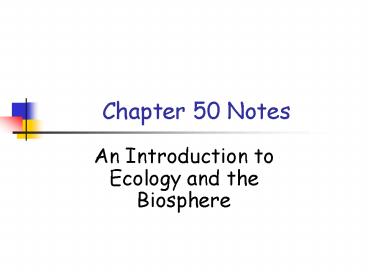Chapter 50 Notes - PowerPoint PPT Presentation
1 / 26
Title:
Chapter 50 Notes
Description:
Chapter 50 Notes An Introduction to Ecology and the Biosphere The Scope of Ecology The interactions between organisms and their environments determine the ... – PowerPoint PPT presentation
Number of Views:102
Avg rating:3.0/5.0
Title: Chapter 50 Notes
1
Chapter 50 Notes
- An Introduction to Ecology and the Biosphere
2
The Scope of Ecology
- The interactions between organisms and their
environments determine the distribution and
abundance of organisms - - Why are there no malaria-carrying mosquitoes
in Minnesota? - - Why are there so many deer in Ohio?
3
The Scope of Ecology
- What factors limit the geographic range, or
distribution, of a species? - What factors determine the abundance of a
species? - The environment of any organism will include both
biotic (living) and abiotic (nonliving)
components.
4
The Scope of Ecology
- Ecology can be divided into four increasingly
comprehensive levels of study - Organismal ecology concerned with the
morphological, physiological, and behavioral ways
in which organisms meet the challenges of biotic
and abiotic environments
5
The Scope of Ecology
- Population ecology concentrates on factors that
affect how many individuals of a particular
species live in an area - Community ecology deals with interacting species
in a community
6
The Scope of Ecology
- Ecosystem ecology emphasis is on energy flow and
the cycling of chemicals among biotic and abiotic
components - Biosphere the global ecosystem the sum of all
the earths ecosystem
7
Factors Affecting the Distribution of Organisms
- Darwin and Wallace began to recognize broad
patterns of geographic distribution - Biogeography the study of the past and present
distribution of individual species
8
Factors Affecting the Distribution of Organisms
9
Factors Affecting the Distribution of Organisms
- Species dispersal contributes to the distribution
of organisms - ex. Why are there no Kangaroos in North America?
- - one way to determine if dispersal is a key
factor limiting distribution is by observing when
humans have transplanted a species
10
Factors Affecting the Distribution of Organisms
- - if a transplant is successful, then the
potential range is larger than its actual range - - if a transplant is unsuccessful, meaning it is
unable to survive and reproduce, then we need to
determine if biotic or abiotic factors exclude it
from this area
11
Factors Affecting the Distribution of Organisms
12
Factors Affecting the Distribution of Organisms
- Problems with introduced Species
- ex. African Honeybee
- - the African honeybee was brought to Brazil in
1956 to produce more honey in the tropics. - - many escaped in 1957 and have been traveling
about 110 km per year ever since.
13
Factors Affecting the Distribution of Organisms
- - beekeepers are worried that the African bee
will damage the established honeybee industry - - will the colder Northern winters prevent them
from moving north?
14
Factors Affecting the Distribution of Organisms
15
Factors Affecting the Distribution of Organisms
- Abiotic factors affect the distribution of
organisms - Temperature
- - affects biological processes
- - most organisms are not able to regulate
internal body temps.
16
Factors Affecting the Distribution of Organisms
- Water
- - availability affects the location of organisms
- - aquatic life must balance water levels
- Sunlight
- - provides the energy that drive most ecosystems
- - distribution on land and in the water
17
Factors Affecting the Distribution of Organisms
- Wind
- - amplifies the affects of environmental
temperatures on organisms - - contributes to water loss
- Rocks and soil
- - physical structures, pH, and mineral
composition of rocks limit the distribution of
plants and animals
18
Factors Affecting the Distribution of Organisms
- Temperature and water are the major climatic
factors determining the distribution of organisms - Climate the prevailing weather conditions at a
locality - Biomes major types of ecosystems that occupy
broad geographic regions
19
Factors Affecting the Distribution of Organisms
- - rainfall and temperature are reasonable means
that correlate with biomes - - climographs are used to measure these factors
20
Factors Affecting the Distribution of Organisms
21
Factors Affecting the Distribution of Organisms
- Global Climate Patterns
- - the suns affect on the atmosphere, land, and
water establish temperature variations - - the tilting of the earth on its axis causes
seasonal variation in the intensity of solar
radiation
22
Factors Affecting the Distribution of Organisms
- Tropics regions between 23.5o north latitude and
23.5o south latitude - - receive the least seasonal change
- - intense solar radiation initiates global
circulation of air, which creates precipitation
and winds
23
Factors Affecting the Distribution of Organisms
24
Factors Affecting the Distribution of Organisms
- Local and seasonal effects on climate
- - the proximity to water and topographic
features such as mountain ranges create climate
patchiness - - ocean currents influence the climate along the
coasts of continents - - seasonal changes in wind patterns produce
variations in ocean currents
25
Factors Affecting the Distribution of Organisms
- - with seasonal changes, turnover will occur in
lakes and ponds - - turnover brings oxygenated water from the
surface of lakes to the bottom and nutrient-rich
water from the bottom of lakes to the surface - - microclimate climate on a very fine scale
26
Factors Affecting the Distribution of Organisms































